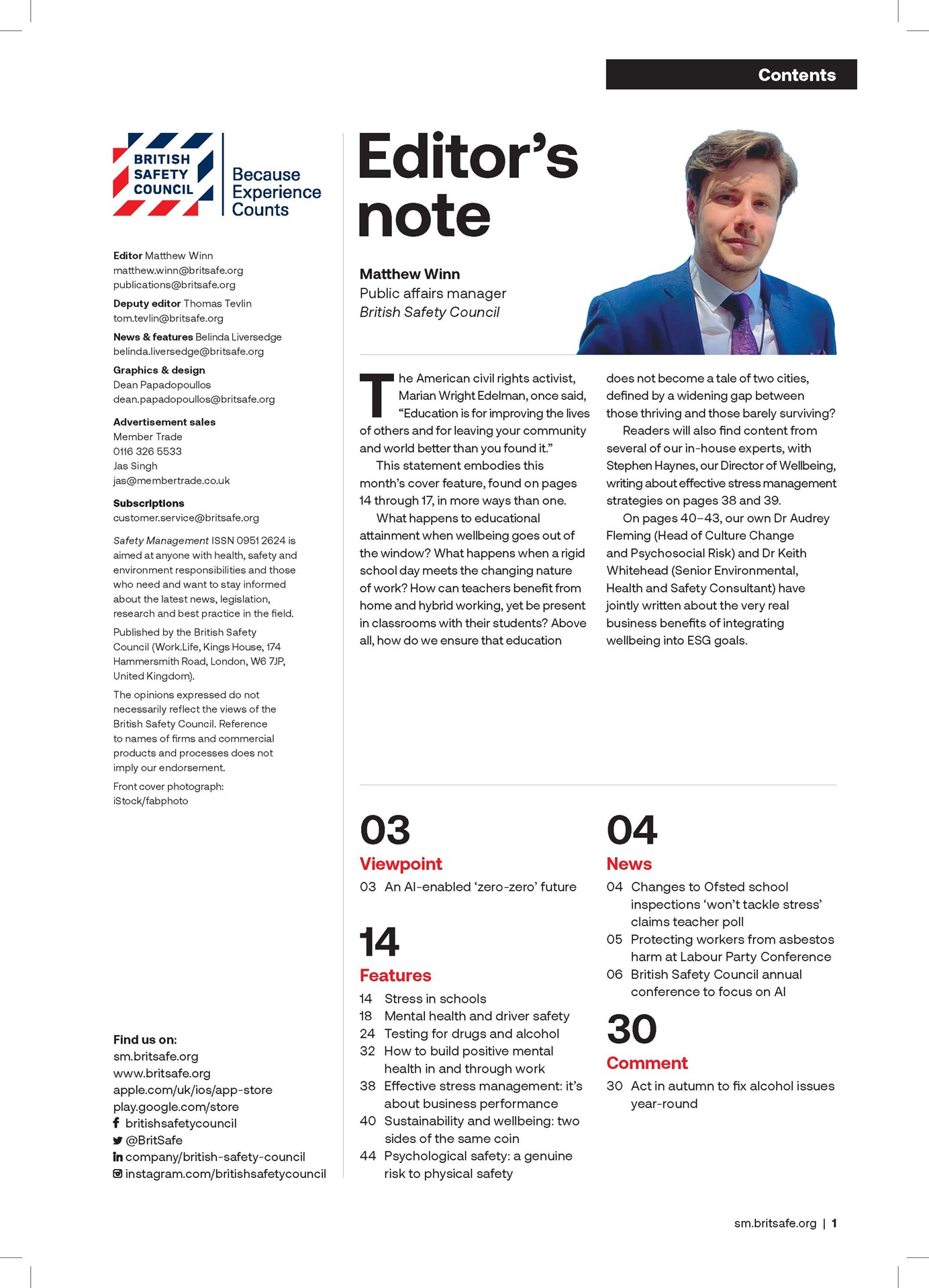Although the UK has a framework for managing asbestos in buildings, a proposed new Asbestos Information Certificate rating dutyholder compliance with the relevant legal duties would place greater emphasis on ensuring building owners are adequately reducing the risk to occupants and tradespeople.
Opinion
Control of Asbestos Regulations: why it’s now time for a review
Three years ago, the House of Commons Work and Pensions Committee instigated an inquiry into the Health and Safety Executive’s (HSE’s) approach to asbestos management in the UK. In this article, we revisit the findings of the inquiry¹ and also examine the progress made since the Government, via HSE, published its response² to the inquiry report in 2022.
 Photograph: iStock/Paul D Wade
Photograph: iStock/Paul D Wade
The subject of asbestos management in general will also be put into context by looking at the approach to other compliance issues, such as energy performance certificates, fire (in the wake of the Grenfell tragedy) and damp and mould in the social housing sector.
History of reviews
Regular review has always been a part of the UK’s health and safety framework, from the Robens report which led directly to the passing of the 1974 Health and Safety at Work Act through to the Löfstedt Review in 2011 and others in more recent years.
Prompted by the newly formed coalition government in 2010, the Löfstedt Review looked at more than 200 pieces of legislation and 50 Approved Codes of Practice with the assumption that many were unnecessary and a hindrance to UK plc. In fact, the review found there were actually fewer regulations in 2011 than the 1970s and resulted in only two statutory instruments being withdrawn.³
Regular changes to legislation
Changes to health and safety law have been happening in roughly 10- to 20-year cycles ever since the Factories Act of 1961. The 1980s saw new Statutory Instruments, such as the Control of Substances Hazardous to Health (COSHH), the Control of Lead at Work Regulations and Noise at Work Regulations.
In 1995, we had the introduction of the first Construction (Design and Management) Regulations (CDM), the most far-reaching set of legal obligations for the construction industry, which prevailed in their original form until an update in 2015.
With asbestos, the 1969 regulations introduced the first Control Limit, and were followed by the 1983 Licensing Regulations and the Control of Asbestos at Work Regulations (CAWR) in 1987. These enshrined the fundamentals of reducing and preventing the spread of asbestos and exposure to it; principles which remain embedded in CAR 2012 (Control of Asbestos Regulations 2012) to this day.
The Duty to Manage came about with CAWR 2002 and this emphasis on ‘managing’ asbestos remains HSE’s primary focus. At the time, it was introduced as not so much a new regulation, but one that merely made explicit the need to manage asbestos as just one of any number of health and safety hazards required by the Management of Health and Safety at Work Regulations 1999.
HSE progress on the report recommendations
The Work and Pensions Committee report made a total of 16 recommendations, three of which the Government and HSE have stated they will not be pursuing, including:
- The development of a central digital register for asbestos in non-domestic premises
- The formulation of an eradication programme to remove asbestos from non-domestic premises over the next 40 years.
Of the remaining recommendations, HSE has already started work on some of these, not least by recruiting an asbestos technical lead to steer them through. Some ‘low hanging fruit’ has already been picked, such as the five-yearly Post Implementation Review of CAR 2012 published in December 2022, which concluded no significant changes were necessary. And there was also the recommendation to look into the extent to which employers are complying with the Duty to Manage using inspection programmes. This has been achieved by HSE conducting a follow-up to its Management of Asbestos in School Buildings report.⁴
 Mick Dawson is a Management Committee member at Asbestos Testing and Consultancy Association (ATaC) and director at DAC asbestos consultancy.
Mick Dawson is a Management Committee member at Asbestos Testing and Consultancy Association (ATaC) and director at DAC asbestos consultancy.
A further recommendation regarding enhancing its messaging and communications to dutyholders has resulted in two campaigns launched by HSE at the beginning of 2024: Asbestos and You (aimed at the trades sector) and Asbestos: Your Duty (aimed at those who own and manage buildings).
Progress has also been made regarding the consideration to make it mandatory for anyone carrying out asbestos surveys to be UKAS-accredited. Earlier this year, HSE asked for responses via a questionnaire on its website to assess the feasibility of this.
To recap on the status of accreditation for carrying out asbestos identification and monitoring: it is a legal requirement to be UKAS-accredited in order to conduct the analysis of asbestos samples in a laboratory and for carrying out asbestos air testing; specifically, the signing off of asbestos removal enclosures via the Certificate for Reoccupation process.
However, it has never been a requirement to be accredited for surveying buildings for asbestos. This anomalous situation means while there is mandatory licensing and accreditation for the removal of asbestos, laboratory identification and air testing following its removal, there is no similar mandate for those tasked with finding and identifying it in the first place. In fact, there is no requirement for any sort of training or certification for surveys, so anyone could set themselves up as an asbestos surveyor and ignore the current voluntary arrangements by opting out.
To many outside the asbestos consulting sector this must seem like a glaring oversight and one that could be easily rectified. Indeed, the arguments which brought in mandatory accreditation for conducting air tests in 1998 and the analysis of samples in 2002 are more or less the same as those surrounding survey accreditation, and a number of industry stakeholders are urging HSE to close this loophole.
The purpose of an overhaul (or what does better look like?)
If we are indeed due a 20-year review of the asbestos framework, we need to ask ourselves what would be the purpose of any such changes and how would they be achieved. The primary purpose of the asbestos regulations as they were structured in 1987 still stands: to reduce and ideally prevent exposure by managing asbestos in situ rather than eradicating it.
But successive reports and studies over the years have shown that dutyholders are still not robustly managing asbestos. The All Party Parliamentary Group on Occupational Safety and Health’s report, Asbestos in Schools⁵, published in 2012; the 2019 Airtight on Asbestos/ResPublica report, Don’t Breathe In: Bridging the Asbestos Safety Gap⁶; the 2022 ATAC/NORAC report, Review of UK Asbestos Managment⁷, and even HSE’s own Management of Asbestos in School Buildings⁴ in 2023 have all highlighted, to a greater or lesser extent, how common these failings are.
To answer the question posed in the sub-heading above, ‘better’ would look like a country with no asbestos in its buildings. Or rather, this is what ‘best’ would look like, hence the Work and Pensions Committee recommendation for a 40-year eradication programme, first proposed by the Occupational Health and Safety APPG in 2012, but summarily rejected by the Government and HSE. Alternatively, maybe ‘better’ would look like having a central asbestos register for UK buildings, again rejected by the Government and HSE.
So, what does that actually leave us with? Well, there is a third way to educate dutyholders regarding the benefits of finding, assessing and recording asbestos, which takes its lead from compliance ratings and metrics used for other building hazards. With fire we have a body, the Building Safety Regulator, established as a parallel regulator to HSE but specifically for cladding and high-rise buildings. Similarly, the 2023 Social Housing Regulation Act legislated for measures⁸ to ensure social landlords deal with domestic hazards, namely damp and mould, in a timely manner and was established in the wake of the death of two-year-old Awaab. And there are energy performance certificates for the rating of a building’s overall energy efficiency.
Out of this comes the Asbestos Information Certificate (AIC), which will rate dutyholder compliance with the asbestos regulations using the familiar colour-coded A to G scale used to rate the efficiency of electrical goods. Currently in its development stage, the AIC will assess the level of compliance in two parts: the first will deal with the asbestos survey and the second will look at the register and management plan as well as providing statutory training, robust means to pass on asbestos information to anyone who needs it, carrying out intrusive refurbishment surveys before any work starts and completing regular re-inspections and reviews.
The AIC is being trialled across a range of sectors involving commercial property agents, registered social landlords and schools. What has become increasingly clear since the Duty to Manage (Regulation 4 of CAR 2012) was introduced in 2002, is that asbestos can be easily managed in buildings with low maintenance requirements and those where major refurbishments are unlikely to take place. But higher maintenance properties, such as our immediate post-war stock of predominantly 1960s buildings, are over 60 years old and are now reaching the end of their viable life.
It is these buildings which require higher levels of maintenance and refurbishment and this will only increase in the future with retrofits and refurbishments required by the country’s net zero commitments. It is no wonder then that the most common breach of the asbestos regulations is Regulation 5, which requires the identification of asbestos before maintenance or refurbishment work starts. This regulation applies to all types of premises, including residential, and does not have any property exemptions like the Duty to Manage which applies only to non-domestic premises.
In the year from June 2023 to May 2024, HSE issued 71 enforcement notices against CAR 2012 as a whole and 54 of these (76 per cent) were for failure to comply with Regulation 5.⁹ From this figure it is clear that the carrying out of a refurbishment survey as a legal requirement comes as some surprise to many involved with building and construction in the UK who thought perhaps it was merely good practice.
Acting now
One strand of the Work and Pensions Committee inquiry that seems to have been forgotten was the call to consider what other parts of the world, such as European countries and Australia, are doing to further manage asbestos and to improve on long-standing techniques and strategies. These countries are developing various combinations of:
- Giving consideration to the phased eradication of asbestos
- Lowering the occupational exposure limit for asbestos
- Using analytical techniques with greater sensitivity such as electron microscopy
- Initiating environmental and background monitoring of asbestos in air
- Implementing strategic national asbestos plans
- Compiling national asbestos databases.
The Netherlands, France, Germany and Australia have each started at least two of the above initiatives and, in the case of the Netherlands, are pressing ahead with all of them. Here in the UK, we are yet to commit to any of them and are in danger of falling behind our peer group in terms of an overhaul of our long-established framework, one in which we were very much the leader until relatively recently.
And given the UK has the highest rate of mesothelioma in the world we are clearly not in a position to stand still. If we don’t act now to modernise our asbestos strategy, we will be seen as the ‘sick man of Europe’ once again.
Mick Dawson is a Management Committee member at Asbestos Testing and Consultancy Association (ATaC) and director at DAC asbestos consultancy.
For more information see:
linkedin.com/company/atac-asbestos-testing-and-consultancy-/
References
- House of Commons Work and Pensions Committee report (2022). tinyurl.com/4cuf9tep
- The Health and Safety Executive’s approach to asbestos management: Government Response to the Committee’s Sixth Report of Session 2021–22 – Work and Pensions Committee (2022). tinyurl.com/yj244xaj
- Löfstedt Review Report (2011). tinyurl.com/54utxj46
- Management of asbestos in school buildings 2022–23: HSE (2023). tinyurl.com/3j54dvcp
- Asbestos in Schools: The need for action; All Party Parliamentary Group on Occupational Health and Safety report (2012). tinyurl.com/bdfszuue
- Don’t Breathe In: Bridging the Asbestos Safety Gap. (2019). tinyurl.com/2xhnetke
- Review of UK Asbestos Management: First Annual Data Analysis Report into Asbestos in UK Buildings, ATaC and NORAC (2022). tinyurl.com/5en6vb38
- Government to deliver Awaab’s Law to force social landlords to fix damp and mould within strict time limits, in new amendment to the Social Housing Regulation Bill, Department for Levelling Up, Housing and Communities (2023). tinyurl.com/29m8349u
- HSE – Register of prosecutions and notices (2023–24). hse.gov.uk/enforce/convictions.htm
OPINION

Don’t lose autism in the neurodiversity wave – why targeted reform is essential
By Rt Hon Sir Robert Buckland KBE KC on 03 December 2025
Autistic adults have waited too long for meaningful reform. They have shared their experiences and expertise. Now they deserve action, accountability, and transformation.

Inclusion saves lives: embedding equality, diversity and inclusion (EDI) into global occupational safety and health
By Umer Changaiz, CMIOSH on 03 December 2025

Work-related road risk – steering clear of danger
By Ben Pepper, CL Medilaw on 30 October 2025
Each day across the UK, millions of employees take to the roads as part of their working lives. Whether delivering parcels, attending client meetings or riding bicycles between jobs, road use plays a vital role in keeping businesses going. While the general health and safety landscape has evolved significantly over recent decades, work-related road risk (‘WRRR’) remains an area that is too often overlooked by employers.



